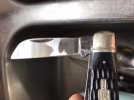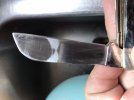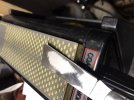Here I describe and illustrate what I propose as an easier approach to freehand sharpening—especially for beginners who will have trouble holding a consistent angle—compared to the "textbook" advice to follow the factory edge angle with every grit. I prepared this for
@AlexSav but I am posting it for general consumption and critique.
Instruction
First the blade is thinned on a fast cutting abrasive. One does not try to actually sharpen (apex) the edge in this phase. Pressure is applied just above the original bevel shoulder with the knife nearly flat on the stone. (This obviously will scratch up the blade finish; hesitancy to do so can be a major hurdle of learning freehand sharpening.) Exact angle control is unnecessary; all that is important is never raising the spine too much which would round off the nascent edge. Firm pressure is used. A burr may be formed incidentally but it is not desired. If wet/dry sandpaper is being used for thinning strokes should be made away from the edge, at least toward the end of the process. (3M "ProGrade Precision with Cubitron II" paper works well for this if a suitable coarse stone is unavailable.)
The thinned area may be refined with finer grits after initial shaping both for appearance and reduced drag, but again the apex is not intentionally refined unless a burr was formed on the previous grit. If a burr was formed light pressure should be used to finish. The burr will remain but it will be less coarse, making the next phase easier.
A break should be taken so that the hands and mind are fresh.
Now the actual apex bevel is applied with care and focus. A wedge with a known angle appropriate for the blade type is used as a reference, and one tries to hold the blade to match while using light pressure and even strokes. (For building motor skill remember: slow is smooth, smooth is fast. Take your time.) If thinning was completed properly contact should be made only very near the apex; if not return to thinning. (Sharpie marker is used to monitor the contact area.)
A variety of sharpening and deburring methods may be employed in this beveling phase, but check sharpness often; this should not take long even with care. The mini-bevel you create can be anything from the width of a hair to about half a millimeter; if it becomes wider than that return to thinning, and try again. (More coarse apex bevels will tend to form wider.)
Explicitly this is not a complete description of sharpening; one needs technique to apply the mini-bevel successfully but it should happen
quickly such that you are able to maintain care and concentration throughout. In the extreme this mini-bevel can be a micro-bevel, applied with deburring strokes alone if the thinning was taken to an apex, but treating it as a true bevel produces a better result. Among other reasons: a blade can be overly thinned without the extra "meat" of a small bevel, though it will take a beginner a lot of patience to actually manifest that problem.
Illustrations
This shall be a schematic view—proportions are not exact and differences are somewhat exaggerated. Pardon the large images; I could not seem to show what I wanted without them.
Here is a representation of the edge of a typical flat-beveled knife when sharp, in cross-section. The blade grind is where the blade finish (black coating, stone wash, etc.) stops. This profile in black will serve as a reference background in all following drawings, each in color and overlaid.
(blue) The same edge substantially dulled.
(green) The textbook instruction of sharpening matching the existing bevel angle. Possible only with a guide. (Note that the bevel shoulder becomes slightly wider as it is cut farther up into the blade; after repeated sharpening performance deteriorates until the blade is thinned.)
(yellow) Instead what I believe most new freehand sharpeners produce. This results from a combination of angle variation and the fact that a stone cuts faster when pressure is higher, i.e. where it hits the shoulder or apex-area rather than the bevel flat. The effect is often compounded by using a slower cutting stone than ideal, as well as the instruction to use all grits at the same angle, resulting in fatigue or frustration and more wobble. The apex is further rounded because the new sharpener is unable to consistently hit it without raising the angle.
(red) The target geometry that I propose, formed through a combination of significant thinning with a fast cutting abrasive, and a new edge bevel a fraction of the size of the original formed with fine abrasives. Both zones show convexity due to anticipated wobble; in this drawing they blend together but they are worked independently.
A magnified comparison of the edge of the last two illustrations.










